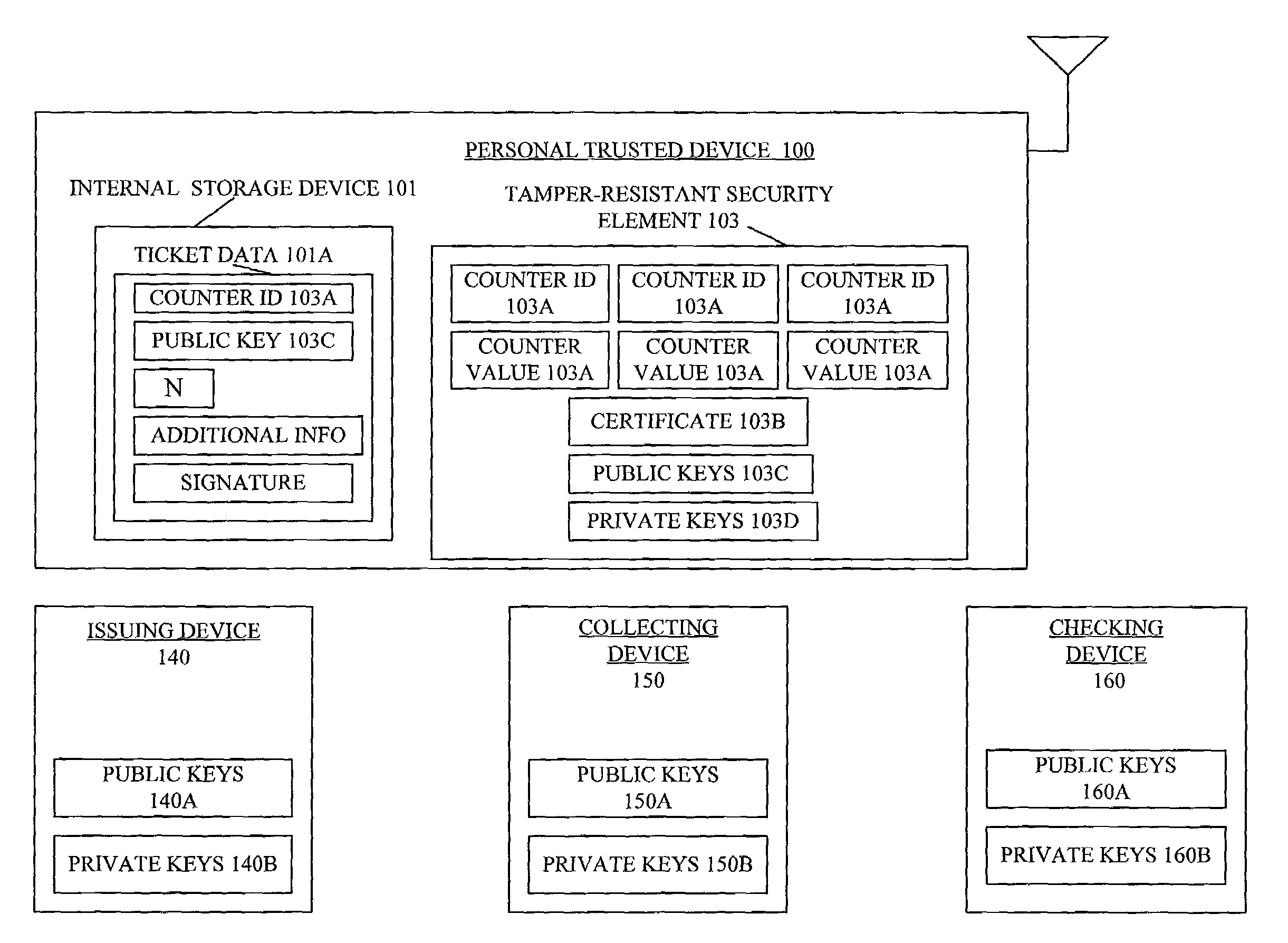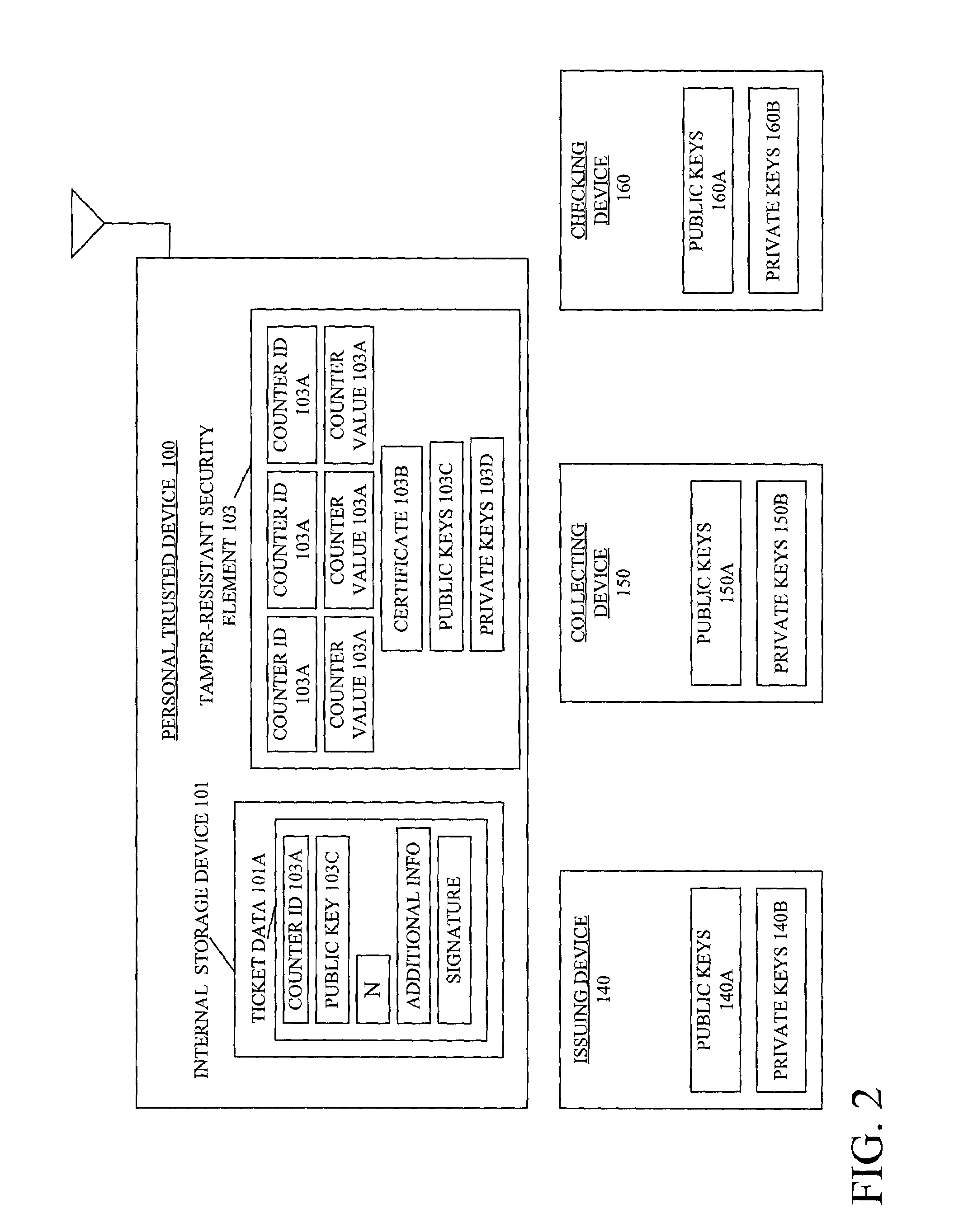[0007]Symmetric key algorithms use an identical
cipher key for both encrypting by the sender of the communication and decrypting by the
receiver of the communication. Symmetric key cryptosystems are built on the mutual trust of the two parties sharing the
cipher key to use the
cryptosystem to protect against distrusted third parties. A well-known
symmetric key algorithm is the National Data
Encryption Standard (DES)
algorithm first published by the National Institute of Standards and Technology. See Federal Register, Mar. 17, 1975, Vol. 40, No. 52 and Aug. 1, 1975, Vol. 40, No. 149. The sending cryptographic device uses the DES
algorithm to encrypt the message when loaded with the
cipher key (a DES cipher key is 56 bits long) for that session of communication (the
session key). The recipient cryptographic device uses an inverse of the DES algorithm to decrypt the encrypted message when loaded with the same cipher key as was used for
encryption.
[0007]Symmetric key algorithms use an identical cipher key for both encrypting by the sender of the communication and decrypting by the
receiver of the communication. Symmetric key cryptosystems are built on the mutual trust of the two parties sharing the cipher key to use the
cryptosystem to protect against distrusted third parties. A well-known
symmetric key algorithm is the National Data
Encryption Standard (DES) algorithm first published by the National Institute of Standards and Technology. See Federal Register, Mar. 17, 1975, Vol. 40, No. 52 and Aug. 1, 1975, Vol. 40, No. 149. The sending cryptographic device uses the DES algorithm to encrypt the message when loaded with the cipher key (a DES cipher key is 56 bits long) for that session of communication (the
session key). The recipient cryptographic device uses an inverse of the DES algorithm to decrypt the encrypted message when loaded with the same cipher key as was used for encryption.
[0010]Therefore, it is desirable to provide a system, method and computer program product that provides secured ticketing in a communications device, such as e.g., personal trusted device using a tamper-resistant security element. The system, method and computer program product of the embodiment of present invention disclosed herein address this need.
[0040]FIG. 4 illustrates the steps involved for executing the request and store ticket protocol that is used for receiving and storing electronic tickets in the personal trusted device 100. Initially, in step S1 mobile equipment 102 requests the card
certificate 103B stored in the security element 103. In anther embodiment of the invention the card
certificate itself is not stored in the security element 103, but a pointer to the card
certificate in the form of an URL address is stored in the security element 103, wherein in step S1 the mobile equipment 102 requests the card certificate from the URL. As mentioned previously, the certificate ensures that the security element 103 is issued by a trusted manufacturer. In step S2 the security element 103 sends a card certificate 103B, which is verified by the mobile equipment 102 as a compliant card using a certificate chain. Two certificates can be used in order for mobile equipment 102 to verify that the security element 103 possesses a compliant card certificate 103B. For example, a certificate issued by the mobile equipment 102 to the manufacturer of the security element 103, and a compliant card certificate issued by the manufacturer of the security element 103 to the security device 103 itself. In step S2, the security element 103 also sends a public key 103C or the card certificate 103B. In step S3, the mobile equipment 102 issues a create counter request to create a new counter to correspond to the electronic ticket that is to be received and later redeemed and / or checked by
third party devices 140, 150, 160. In step S4, the security element 103 sends a counter ID that is used to uniquely identify a counter. In step S5, the mobile equipment 102 forwards the counter ID, and the public key and manufacturer certificate of the external security element 103 to the issuing device 140. In step S6, the issuing device 140 creates a ticket. The ticket is a signature on authenticator data for the issuing device consisting of the counter ID 103A, the public key 103C and a number of uses N (not shown) of the ticket created. The number of uses is, for example, the number of uses allowed by the user for this ticket (e.g., 10-use ticket will have N=10). In addition, the authenticator data may include other
relevant information, such as e.g., a seat number and / or a date and / or time related to the ticket, to be used by the personal trusted device 100. By way of example, the ticket issued using the issue ticket protocol resembles ticket=Sig_Issuer(counterID / Public Key_Device 103 / N / other_info). In step S6, the ticket is sent to the mobile equipment 102 and stored in the internal storage device 101.
[0022]FIG. 1 is an embodiment of the present invention that illustrates a system for secured ticketing in a communications device. The personal trusted device 100 is a
wireless handheld telephone, a
satellite telephone, a personal digital assistant, or a
bluetooth device or any other communications device. The personal trusted device (PTD) 100 includes a mobile equipment (ME) 102 and a secure element 106. The mobile equipment 102 includes an internal storage device 101,
operating system 107 and central processor 210. The external memory 106 includes a tamper-resistant security element (SE) 103. Tamper-resistant is a term known in the art that defines a secure section or memory or storage. A tamper-resistant boundary makes it difficult for an attacker to get at an internal element or data within a secure section. An example of security element framework is an ISO / IEC 7816, identification card-
integrated circuit(s) cards with contacts, and utilizing AID (
application identifier) defined in ISO / IEC 7816—with added functionality according to the embodiment of the invention. Other examples include secure MMC (
Multimedia Card),
embedded hardware, etc. The security element 103 is an electronic card such as smartcard, flashcard or WIM card that is received by the personal trusted device 100 and completely removable.
 Login to View More
Login to View More  Login to View More
Login to View More 


